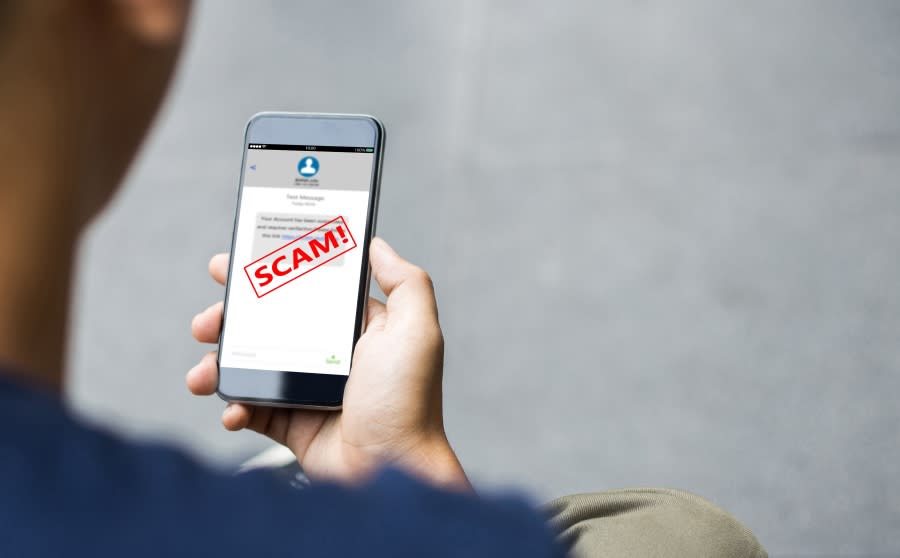Sick of those scam text messages? What you can do

Story at a glance
Scammers use a variety of tactics to trick users into giving up personal information like passwords and Social Security numbers.
After that, they could use that information to gain access to your accounts or they could even sell your information to someone else.
If you think a message is real but aren’t sure, contact the specific company by using a phone number from an official website that you know is real.
DENVER (KDVR) – Scammers are getting more advanced every day. From a simple text that says, “track your package with this link,” to a message that promises to help pay off loans or give you a coupon code, there are a variety of tactics used.
But how can you tell if it’s a scam text? And is there a way to stop the fake messages?
How to recognize a scam text
It can be difficult sometimes to recognize a spam message. According to the Federal Trade Commission, scammers will send fake text messages to try and trick you into giving them personal information, like a password, account number, or Social Security number.
After that, they could use that information to gain access to your accounts or they could even sell your information to someone else.
Odometer rolled back 100,000 miles then sold to customer
These are some ways scammers might try to get your information, according to the FTC:
They might try to say they’ve noticed suspicious activity on your account
Claim there’s a problem with your payment information
Send you a fake invoice and tell you to contact them if you didn’t authorize the purchase
Send you a package delivery notification
Promise free prizes, gift cards, or coupons
Offer you a low or no interest credit card
Promise to help you pay off your student loans
If you think a message is real but aren’t sure, contact the specific company by using a phone number from an official website that you know is real.
What should you do if you get a scam text?
Here is what you should do if you get a scam text:
Copy the message, without clicking on a link, and forward it to 7726 (SPAM). This helps your wireless provider spot and block similar messages in the future.
Report it on the messaging app you use. Look for the option to report junk or spam.
Report it to the FTC at ReportFraud.ftc.gov.
Can you stop the fake texts?
The Federal Communication Commission says that rules ban text messages sent to a mobile phone using an auto-dialer, unless you previously gave consent to receive the message or the message is sent for emergency purposes.
Here is what the FCC said to do to try and stop these spam messages from happening:
Do not respond to unwanted texts from questionable sources. Several mobile service providers allow you to block the sender by forwarding unwanted texts to 7726 (or “SPAM”).
Be careful about giving out your mobile phone number or any other personal information.
Read through commercial web forms and check for a privacy policy when submitting your mobile phone number to any customer website. You should be able to opt out of receiving texts – but you may have to check or uncheck a preselected box to do so.
Find out if any company you do business with has a policy that allows it to sell or share your information.
Check with your cell service provider to see your options for block spam callers or spam texts
The FCC proposed new rules last week that would require mobile wireless providers to block messages from numbers that appear to be scam-related. Examples include mobile numbers that are invalid, unallocated, unused or have been blocked by the user.
Such rules are already in place for voice calls, according to the FCC.
“Text messaging is among our most popular forms of communication, quickly connecting people to friends and family, businesses to customers, and governments to constituents,” the FCC proposal reads. “But with that popularity comes risk. While unwanted text messages present similar problems as unwanted calls – they invade consumer privacy and are vehicles for consumer fraud and identity theft – they also present harms beyond robocalls that can exacerbate the problem of such scams.”
Along with the FCC recommendations, there are a number of apps such as Nomorobo, Hiya, and Robokiller that purport to wipe out scam texts and calls.
What is “Smishing?”
One of the scams hitting many cell phones is a form of phishing that is called, “smishing.”
The text might say, “Jonathan, urgent notice for your USPS package 97OR442 Available for pick 8:55 a.m. Click this link.”
Even if you are expecting a package, you shouldn’t click the link.
“USPS will not send customers text messages or e-mails without a customer first requesting the service with a tracking number, and it will not contain a link. So, if you did not initiate the tracking request for a specific package directly from USPS and it contains a link: don’t click the link,” the United States Postal Inspection Service said.
If you get a package scam text, here is how you can report it:
Without clicking on the web link, copy the body of the suspicious text message and paste into a new email.
Provide your name in the email, and also attach a screenshot of the text message showing the phone number of the sender and the date sent.
Include any relevant details in your email, for example: if you clicked the link, if you lost money, if you provided any personal information, or if you experienced any impacts to your credit or person.
The Postal Inspection Service will contact you if more information is needed.
If you have not done so yet, make sure your phone is on the Do Not Call list.
For the latest news, weather, sports, and streaming video, head to The Hill.

